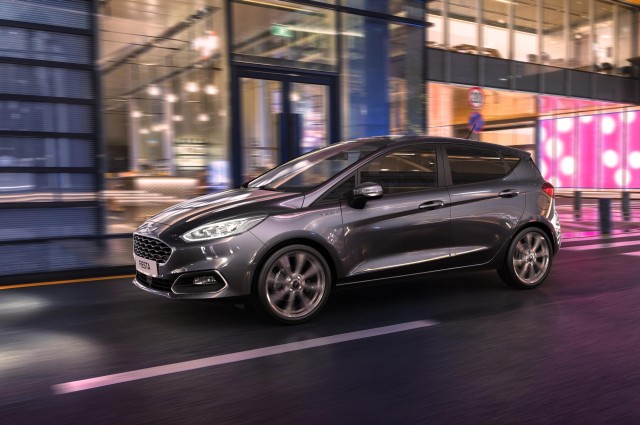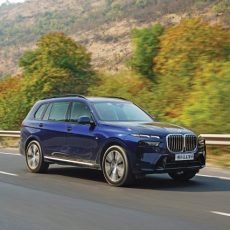The new family of Ford EcoBoost Hybrid engines have arrived with different states of tune and some very interesting choices.

The Ford EcoBoost engine is acknowledged by many as being ahead of its time. The 1.0-litre, three-cylinder turbo-petrol, with its peak output of 125 hp and 170 Nm, had numbers to match much larger 1.8-litre four-cylinder engines. Sadly, it came and went with the EcoSport and, at least in India, we never got a chance to see it shine in something like a Figo or a Fiesta.
There’s more news on that front with the Ford EcoBoost Hybrid engines soon making their way into global markets. And that 1.0 three-pot turbo is going to star yet again.
The new Fiesta, shown in the UK, now gets the new Ford EcoBoost Hybrid electrified powertrain. Running a 48-volt electrical system, it promises improved fuel economy, better driveability and a slew of additional driver aids enabled by the higher-bandwidth electricals including Adaptive Cruise Control with Stop & Go, and Speed Sign Recognition. In addition, the FordPass Connect modem helps deliver a seamless ownership experience and enables remote locking and unlocking via the FordPass mobile app.
A total of five powertrain choices are offered with the new Fiesta. Two of those are the 1.0-litre three-cylinder Ford EcoBoost Hybrid available with either 125 hp or a significantly higher 155 hp. These Ford EcoBoost Hybrid engines feature a belt-driven integrated starter/generator (BISG) in place of the standard alternator. This allows recovery and storage of energy usually lost during braking and coasting to charge the secondary 48V lithium-ion air-cooled battery pack. The BISG also acts as a supplemental motor, integrating with the engine and using the stored energy to provide torque assistance during normal driving and acceleration, as well as running the vehicle’s electrical ancillaries and assistance systems.
This intelligent, self-regulating mild-hybrid system in the Ford EcoBoost Hybrid engines continuously monitors how the vehicle is being used and determines when and how intensively to charge the battery for optimal benefit, and when to utilize the stored battery charge using one of two strategies…
The first is torque substitution. It uses the electric motor to deliver up to 24 Nm of torque and reduces the load on the petrol engine, This also contributes to lower CO2 emissions of 109 g/km and fuel efficiency of 18.70 km/l on the WLTP (Worldwide-harmonized Light-vehicle Test Procedure). The torque substitution allows the 125-hp Ford EcoBoost Hybrid to deliver a fuel efficiency five per cent more than the traditional petrol 125-hp 1.0-litre EcoBoost engine.
The second is torque supplementation. It deploys the electric motor functionality of the BISG to increase the peak torque available from the powertrain by up to 20 Nm above the level available from the petrol engine. This means up to 240 Nm for the 155-hp Ford EcoBoost Hybrid engine and as much as 50 per cent more torque at lower engine speeds.
The BISG on the Ford EcoBoost Hybrid has also lowered the 1.0-litre engine’s compression ratio and allows the addition of a larger turbocharger for more power – thanks to mitigating turbo-lag using torque supplementation that has the engine turning over faster for maintained turbocharger boost response. Furthermore, the more powerful BISG also enables the Ford EcoBoost Hybrid engines Auto Start-Stop technology to operate in a wider range of scenarios for even greater fuel savings, including when coasting to a stop below 24 km/h and even when the vehicle is in gear with the clutch pedal pushed.
The Fiesta with the 1.0-litre Ford EcoBoost Hybrid engine with 125 hp is rated at 109 g/km and 20.60 km/l, while the 155-hp version is rated at 116 g/km and 19.81 km/l. All ratings are for the six-speed manual version on the WLTP cycle. There is also a conventional 125-hp Ford EcoBoost with a seven-speed automatic that’s rated at 129 g/km and 17.70 km/l.
Roelant de Waard, Vice President, Marketing, Sales and Service, Ford of Europe, said, “Adding EcoBoost Hybrid technology to Fiesta’s best-in-class driving dynamics means customers can have even more power and still go further on a tank of fuel. The Fiesta EcoBoost Hybrid will help Ford bring the benefits of electrification to more drivers than ever before.”
Ford are committed to offering an electrified version of every passenger vehicle they have on the European market and aim to grow their portfolio of electrified vehicles in Europe to 18 on sale before the end of next year.




